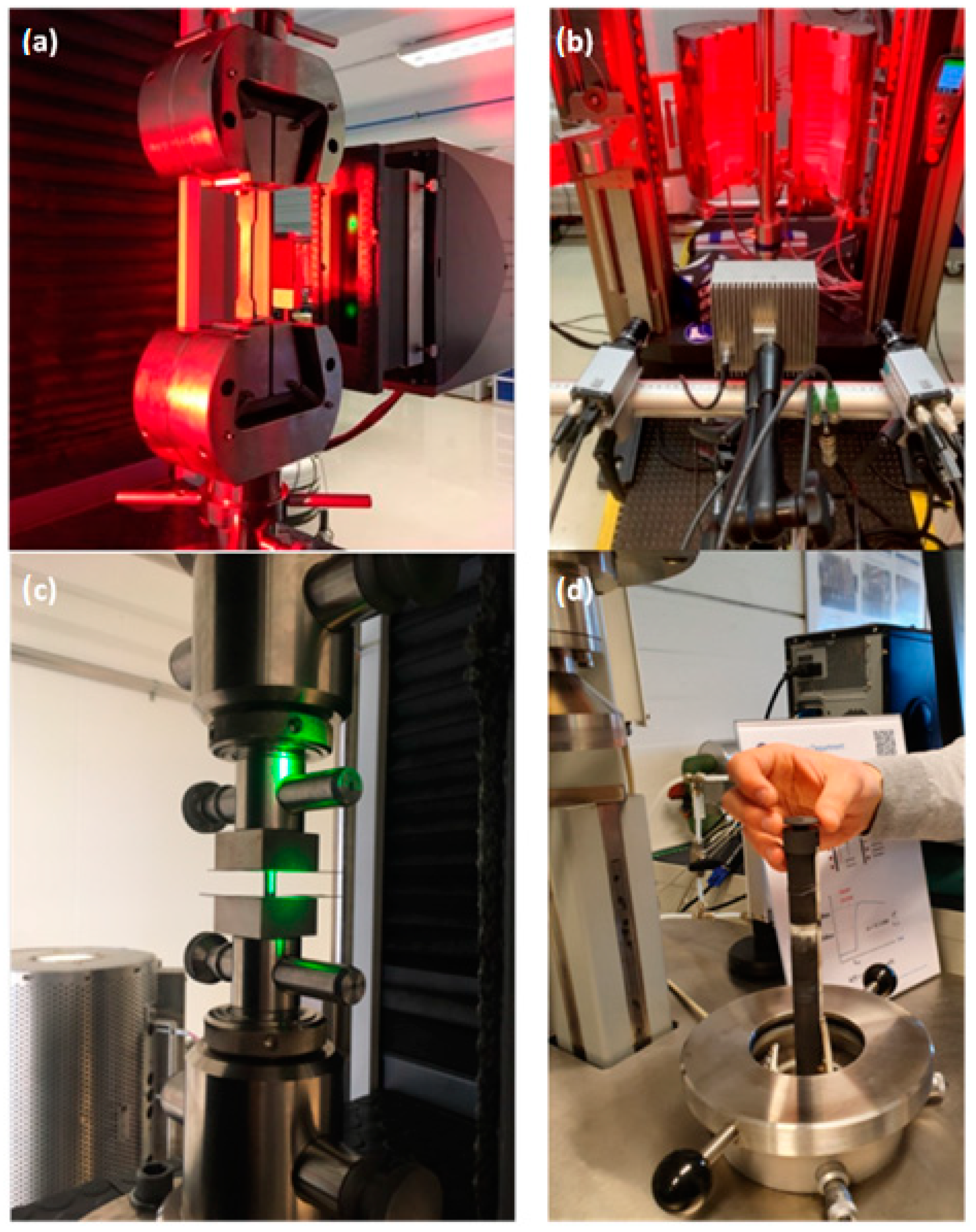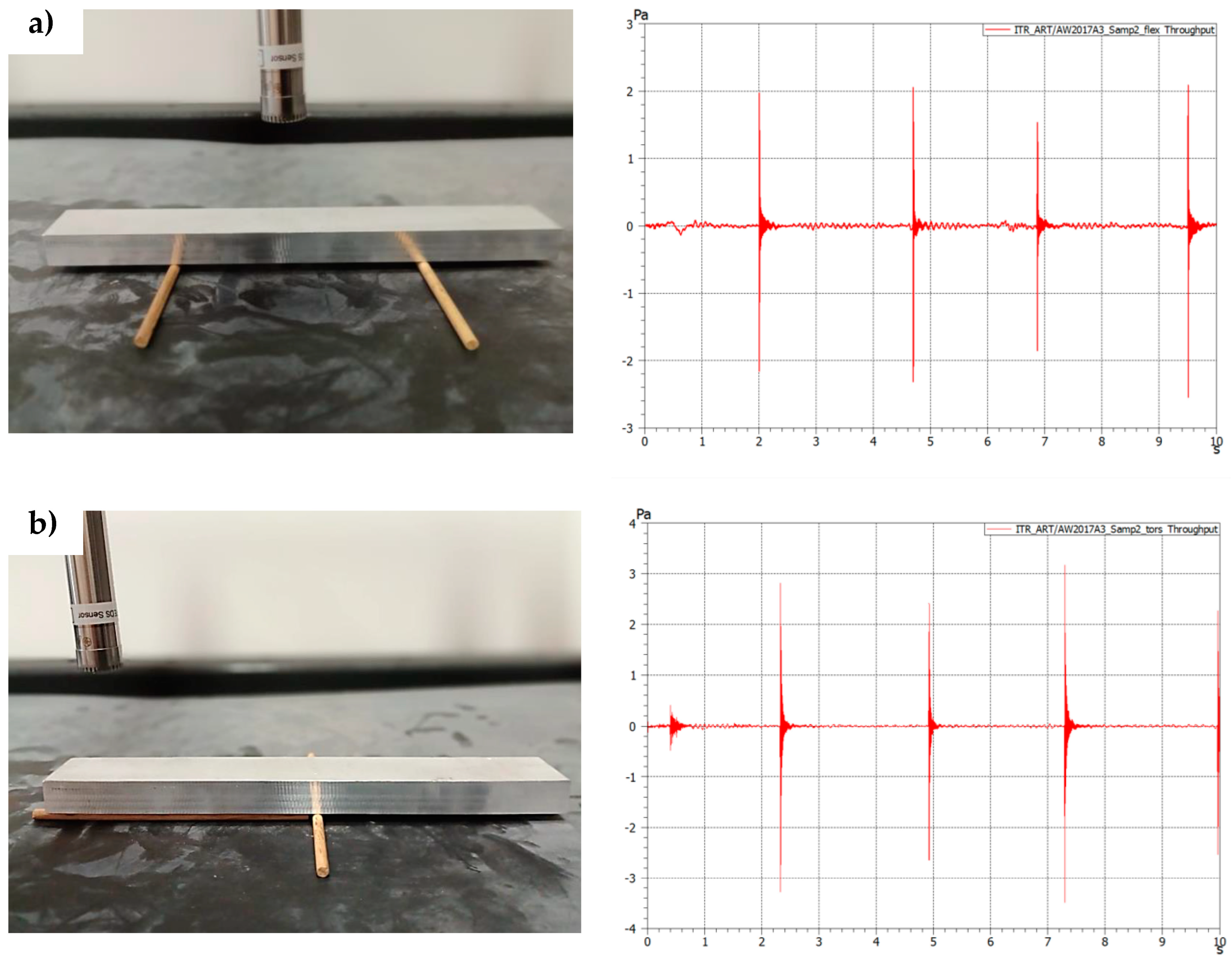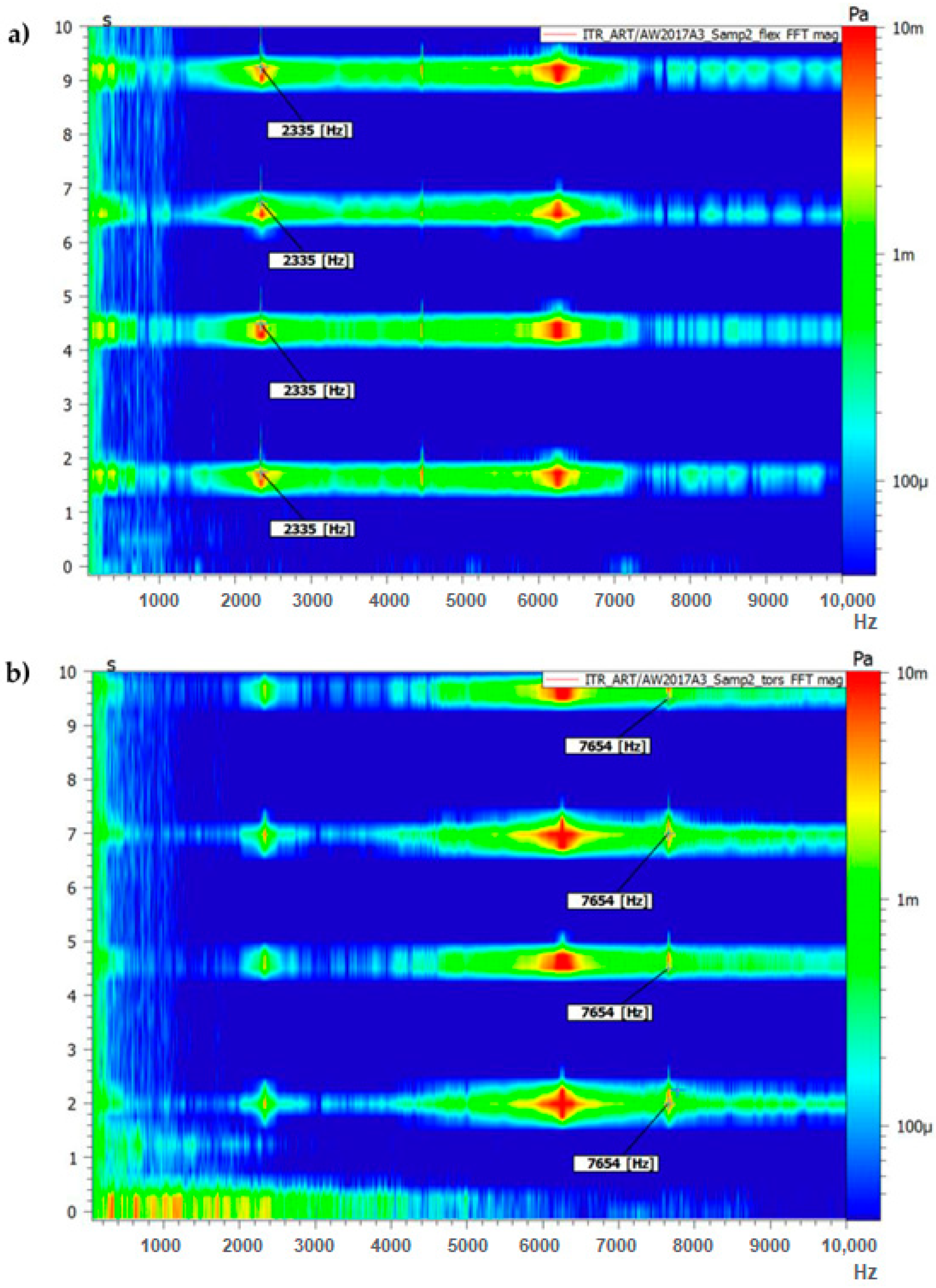Quantification of Construction Materials Quality via Frequency Response Measurements: A Mobile Testing Station
Abstract
:1. Introduction
- Steel: used in the construction of buildings, bridges, and infrastructure due to its strength and durability.
- Aluminium: lightweight, corrosion-resistant, and strong, making it suitable for use in construction, transportation, and infrastructure.
- Copper: commonly used in electrical wiring, plumbing, roofing, and flashing.
- Iron: used in reinforcing concrete, making structural beams, and casting iron pipes.
- Lead: used in roofing, flashing, and radiation shielding.
- Zinc: used for galvanizing steel to protect it from corrosion and for roofing and flashing.
- Visual Inspection: This step requires checking the metal for cracks, corrosion, or other visible defects in construction, structures, and components. This, the most classical approach presented in numerous works [2,3], has been extensively studied in recent years due to the incorporation of many novel optical techniques and algorithms. This includes the use of high-resolution optical devices in connection with specialized algorithms, e.g., neural networks and deep learning [4,5], drones and other Unmanned Aerial Vehicles as inspection agents [6,7], motion amplification cameras or video stream analysis [8,9], and many more.
- Non-Destructive Testing (NDT): This is one of the most common techniques successfully used to inspect building materials and uses sonic and ultrasonic testing based on elastic wave propagation [10]. Another possibility is radiography or tomography techniques, which are especially useful for the discovery of internal defects [11,12]. Similarly, to detect a hidden defect, a magnetic particle inspection technique can be applied [13,14]. This technique, used for ferromagnetic materials (alloys), allows for detecting shallow surface errors and discontinuities.
- Mechanical Testing: This is used to test the metal’s strength, ductility, and hardness to verify that it meets the designer’s needs or can be applied in specific solutions [17]. However, this technique is considered destructive (test sample requirements) and allows for the use of tiny test objects [18].
- Corrosion Testing: This technique is generally based on exposing the metal to a simulated environment to test its corrosion resistance. The data acquired are especially useful for predicting the corrosion effect of structures in an urban environment [19].
- Fatigue Testing: This generally subjects the metal to repeated loading and unloading cycles to assess its ability to withstand repeated stress. This information is precious as input for simulation software (e.g., in the case of new materials) and in the case of high-rise building designs [20,21,22].
2. Materials and Methods
2.1. Material Testing Based on Frequency Response Analysis
2.2. IET Testing Principles and Calculations of Material Elastic Properties
- E—Young’s Modulus, Pa
- m—mass of the sample (a bar), g
- b—width of the sample (a bar), mm
- L—length of the sample (a bar), mm
- t—thickness of the sample (a bar), mm
- —fundamental resonant frequency of sample (a bar) in flexure, Hz
- T1—correction factor for fundamental flexural mode to account for finite thickness of the sample (a bar), Poisson’s ratio, and so forth.
- —dynamic shear modulus, Pa,
- —fundamental resonant frequency of sample (a bar) in torsion Hz.
2.3. Mobile Testing Station Prototype for On-Site Impulse Excitation Testing
- The test station is mobile. Thus, the total weight must be limited so a single person can move it and perform the required tests;
- The test station needs to allow for the testing of tiny samples but also larger ones. Thus, the side and top elements are removable and can be connected in different places or heights (Figure 3 in black-colour elements 1 and 2). Additionally, the holes in each element allow for mounting line pulleys (4b) or flexible lines (4c) for suspending elements in free-free conditions;
- The bottom of the test station (3abc) allows for different tests depending on the users’ needs. It consists of a perforated sheet metal plate (3a) that allows for fixing elements with screws, a layer of a rubber plate (3b) to isolate the testing area from environmental conditions (e.g., ground motion transfer), and a layer of convoluted foam (3c) for testing lightweight materials in near free-free supporting conditions.
- The magnetic feet (4a) allow for fixing sensors or additional elements.
2.4. Materials Used for Mobile Station Testing
- Structural steel (S235 according to European Standard EN 10025 or A283C according to the American Society for Testing and Materials (ASTM)). Due to its universality, structural steel S355 is used to manufacture many of the constructions being created for various purposes. They are used as quality steels with guaranteed parameters sufficient in significant industrial installation applications, from building construction and drilling rigs to pipelines distributing media under increased pressure. This steel is universal due to its usage and suitability for welding. The physical properties of structural steel (EN S235) are presented in Table 1.
- Aluminium alloy (EN AW-2017A or ASTM 2017). The 2017 aluminium alloy is characterized by good strength properties and high tensile and fatigue strength. It is suitable for welding and moderately resistant to corrosion. It is used in the production of structural elements. The physical properties of aluminium alloy (EN AW-2017A) are presented in Table 2.
- Brass alloy (EN CW617N or ASTM C37800). This alloy is characterized by good susceptibility to machining. It is widely used in the production of the forged parts in complex shapes, parts for pipes, industrial clamps, heating elements, water and sewage systems, and industrial fittings. The physical properties of a brass alloy (EN CW617N) are presented in Table 3.
3. Results
4. Conclusions
Author Contributions
Funding
Data Availability Statement
Acknowledgments
Conflicts of Interest
References
- Scislo, L.; Guinchard, M. Non-Invasive Measurements of Ultra-Lightweight Composite Materials Using Laser Doppler Vibrometry System. In Proceedings of the 26th International Congress on Sound and Vibration, Montreal, QC, Canada, 7–11 July 2019; pp. 1–8. [Google Scholar]
- Wiyanto, H.; Makarim, C.A.; Gondokusumo, O.; Siregar, J.P.; Irawan, A.P.; Cionita, T.; Najid, N. Determining Concrete Structure Condition Rating Based on Concrete Compressive Strength. Buildings 2022, 12, 776. [Google Scholar] [CrossRef]
- Sun, X.; Gu, J.; Tang, S.; Li, J. Research Progress of Visual Inspection Technology of Steel Products—A Review. Appl. Sci. 2018, 8, 2195. [Google Scholar] [CrossRef]
- Yang, G.; Liu, K.; Zhang, J.; Zhao, B.; Zhao, Z.; Chen, X.; Chen, B.M. Datasets and Processing Methods for Boosting Visual Inspection of Civil Infrastructure: A Comprehensive Review and Algorithm Comparison for Crack Classification, Segmentation, and Detection. Constr. Build. Mater. 2022, 356, 129226. [Google Scholar] [CrossRef]
- Zhang, X.; Yan, Y.H.; Chen, W.H.; Chen, J.J. Image Fusion Method for Strip Steel Surface Detect Based on Bandelet-PCNN. Adv. Mater. Res. 2012, 546–547, 806–810. [Google Scholar] [CrossRef]
- Falorca, J.F.; Miraldes, J.P.N.D.; Lanzinha, J.C.G. New trends in visual inspection of buildings and structures: Study for the use of drones. Open Eng. 2021, 11, 734–743. [Google Scholar] [CrossRef]
- Dupont, Q.F.M.; Chua, D.K.H.; Tashrif, A.; Abbott, E.L.S. Potential Applications of UAV along the Construction’s Value Chain. Procedia Eng. 2017, 182, 165–173. [Google Scholar] [CrossRef]
- Kong, X.; Li, J. Vision-Based Fatigue Crack Detection of Steel Structures Using Video Feature Tracking. Comput. Civ. Infrastruct. Eng. 2018, 33, 783–799. [Google Scholar] [CrossRef]
- Lado-Roigé, R.; Font-Moré, J.; Pérez, M.A. Learning-Based Video Motion Magnification Approach for Vibration-Based Damage Detection. Measurement 2023, 206, 112218. [Google Scholar] [CrossRef]
- Rodríguez-Mariscal, J.; Canivell, J.; Solís, M. Evaluating the Performance of Sonic and Ultrasonic Tests for the Inspection of Rammed Earth Constructions. Constr. Build. Mater. 2021, 299, 123854. [Google Scholar] [CrossRef]
- du Plessis, A.; Boshoff, W.P. A Review of X-ray Computed Tomography of Concrete and Asphalt Construction Materials. Constr. Build. Mater. 2019, 199, 637–651. [Google Scholar] [CrossRef]
- Schabowicz, K. Non-Destructive Testing of Materials in Civil Engineering. Materials 2018, 12, 3237. [Google Scholar] [CrossRef] [PubMed]
- Sacarea, A.I.; Oancea, G.; Parv, L. Magnetic Particle Inspection Optimization Solution within the Frame of NDT 4.0. Processes 2021, 9, 1067. [Google Scholar] [CrossRef]
- Li, L.; Yang, Y.; Cai, X.; Kang, Y. Investigation on the Formation Mechanism of Crack Indications and the Influences of Related Parameters in Magnetic Particle Inspection. Appl. Sci. 2020, 10, 6805. [Google Scholar] [CrossRef]
- Schabowicz, K. Testing of Materials and Elements in Civil Engineering. Materials 2021, 14, 3412. [Google Scholar] [CrossRef]
- Michałek, J.; Sobótka, M. Assessment of Internal Structure of Spun Concrete Using Image Analysis and Physicochemical Methods. Materials 2020, 13, 3987. [Google Scholar] [CrossRef] [PubMed]
- Saba, N.; Jawaid, M.; Sultan, M.T.H. An Overview of Mechanical and Physical Testing of Composite Materials. Mech. Phys. Test. 2019, 1–12. [Google Scholar] [CrossRef]
- Zhang, J.; Guo, Z.; Liu, K. Mechanical Properties Study of Miniature Steel Specimens Based on the Small Punch Test and Simulation Methods. Materials 2022, 15, 6542. [Google Scholar] [CrossRef]
- Wu, H.; Lei, H.; Chen, Y.F.; Qiao, J. Comparison on Corrosion Behaviour and Mechanical Properties of Structural Steel Exposed between Urban Industrial Atmosphere and Laboratory Simulated Environment. Constr. Build. Mater. 2019, 211, 228–243. [Google Scholar] [CrossRef]
- Liu, C.; Lv, S.; Peng, X.; Zheng, J.; Yu, M. Analysis and Comparison of Different Impacts of Aging and Loading Frequency on Fatigue Characterization of Asphalt Concrete. J. Mater. Civ. Eng. 2020, 32, 04020240. [Google Scholar] [CrossRef]
- Ding, J.; Cheng, L.; Chen, X.; Chen, C.; Liu, K. A Review on Ultra-High Cycle Fatigue of CFRP. Compos. Struct. 2021, 256, 113058. [Google Scholar] [CrossRef]
- Carlesso, D.M.; de la Fuente, A.; Cavalaro, S.H.P. Fatigue of Cracked High Performance Fiber Reinforced Concrete Subjected to Bending. Constr. Build. Mater. 2019, 220, 444–455. [Google Scholar] [CrossRef]
- Allen, E.; Iano, J. Fundamentals of Building Construction: Materials and Methods; Wiley: Hoboken, NY, USA, 2013; ISBN 9781119446194. [Google Scholar]
- Minor, A.M.; Dehm, G. Advances in in situ nanomechanical testing. MRS Bull. 2019, 44, 438–442. [Google Scholar] [CrossRef]
- Giurgiutiu, V. Stress, Vibration, and Wave Analysis in Aerospace Composites; Elsevier: Amsterdam, The Netherlands, 2022; ISBN 9780128133088. [Google Scholar]
- Braun, S.; Simon, G.; Ewins, D.J.; Rao, S.S. Encyclopedia of Vibration; Academic Press: Cambridge, MA, USA, 2002; ISBN 9780122270857. [Google Scholar]
- Tognana, S.; Salgueiro, W.; Somoza, A.; Marzocca, A. Measurement of the Young’s Modulus in Particulate Epoxy Composites Using the Impulse Excitation Technique. Mater. Sci. Eng. A 2010, 527, 4619–4623. [Google Scholar] [CrossRef]
- Popov, I.; Shitikova, M.V. Impulse Excitation Technique and Its Application for Identification of Material Damping: An Overview. IOP Conf. Ser. Mater. Sci. Eng. 2020, 962, 022025. [Google Scholar] [CrossRef]
- Fukumoto, Y.; Takewaki, I. Critical Earthquake Input Energy to Connected Building Structures Using Impulse Input. Earthq. Struct. 2015, 9, 1133–1152. [Google Scholar] [CrossRef]
- Scislo, L. High Activity Earthquake Swarm Event Monitoring and Impact Analysis on Underground High Energy Physics Research Facilities. Energies 2022, 15, 3705. [Google Scholar] [CrossRef]
- Scislo, L. Single-Point and Surface Quality Assessment Algorithm in Continuous Production with the Use of 3D Laser Doppler Scanning Vibrometry System. Sensors 2023, 23, 1263. [Google Scholar] [CrossRef]
- Roebben, G.; Bollen, B.; Brebels, A.; Van Humbeeck, J.; Van der Biest, O. Impulse Excitation Apparatus to Measure Resonant Frequencies, Elastic Moduli, and Internal Friction at Room and High Temperature. Rev. Sci. Instrum. 1997, 68, 4511–4515. [Google Scholar] [CrossRef]






| Density [kg/cm3] | Electr. Conductivity [MS/m] | Thermal Conductivity [W/(mK)] | Modulus of Elasticity [GPa] | Shear Modulus [Gpa] | Poisson’s Ratio | Specific Heat [J/(kg·K)] |
|---|---|---|---|---|---|---|
| 7800 | ≈12 | 40–45 * | 205–2010 * | 80–82 * | 0.25–0.30 * | 460–480 * |
| Density [kg/m3] | Electr. Conductivity [MS/m] | Thermal Conductivity [W/(mK)] | Modulus of Elasticity [GPa] | Shear Modulus [GPa] | Poisson’s Ratio | Specific Heat [J/(kg·K)] |
|---|---|---|---|---|---|---|
| 2790 | ≈28 | 130–200 * | 72–74 * | 27–28 * | 0.34–0.37 * | 840–860 * |
| Density [kg/m3] | Electr. Conductivity [MS/m] | Thermal Conductivity [W/(mK)] | Modulus of Elasticity [GPa] | Shear Modulus [GPa] | Poisson’s Ratio | Specific Heat [J/(kg·K)] |
|---|---|---|---|---|---|---|
| 8430 | ≈15 | 110–120 | 95–125 * | 35–44 * | 0.34–0.40 * | ≈377 * |
| Sample/ Measurement Number | Flexural Resonant [kHz] | Torsional Resonant [kHz] | Mass m [g] | Length L * [mm] | Width b * [mm] | Hight t * [mm] | Young Modulus E [GPa] | Shear Modulus G [GPa] | Poisson’s Ratio |
|---|---|---|---|---|---|---|---|---|---|
| Steel | |||||||||
| S1/1 | 2.335 | 7.973 | 236 | 150 | 20 | 10 | 205.524 | 81.817 | 0.256 |
| S1/2 | 2.335 | 7.973 | 236 | 150 | 20 | 10 | 205.524 | 81.817 | 0.256 |
| S1/3 | 2.335 | 7.973 | 236 | 150 | 20 | 10 | 205.524 | 81.817 | 0.256 |
| S2/1 | 2.335 | 7.964 | 236 | 150 | 20 | 10 | 205.524 | 81.632 | 0.259 |
| S2/2 | 2.335 | 7.964 | 236 | 150 | 20 | 10 | 205.524 | 81.632 | 0.259 |
| S2/3 | 2.335 | 7.964 | 236 | 150 | 20 | 10 | 205.524 | 81.632 | 0.259 |
| S3/1 | 2.336 | 7.967 | 236 | 150 | 20 | 10 | 205.700 | 81.694 | 0.259 |
| S3/2 | 2.336 | 7.967 | 236 | 150 | 20 | 10 | 205.700 | 81.694 | 0.259 |
| S3/3 | 2.336 | 7.967 | 236 | 150 | 20 | 10 | 205.700 | 81.694 | 0.259 |
| Average | 205.583 | 81.714 | 0.258 | ||||||
| Aluminum | |||||||||
| S1/1 | 2.337 | 7.653 | 85 | 150 | 20 | 10 | 73.517 | 27.079 | 0.357 |
| S1/2 | 2.337 | 7.653 | 85 | 150 | 20 | 10 | 73.517 | 27.079 | 0.357 |
| S1/3 | 2.337 | 7.653 | 85 | 150 | 20 | 10 | 73.517 | 27.079 | 0.357 |
| S2/1 | 2.335 | 7.654 | 85 | 150 | 20 | 10 | 73.517 | 27.079 | 0.357 |
| S2/2 | 2.335 | 7.654 | 85 | 150 | 20 | 10 | 73.517 | 27.079 | 0.357 |
| S2/3 | 2.335 | 7.654 | 85 | 150 | 20 | 10 | 73.517 | 27.093 | 0.357 |
| S3/1 | 2.336 | 7.649 | 85 | 150 | 20 | 10 | 74.087 | 27.093 | 0.367 |
| S3/2 | 2.336 | 7.649 | 85 | 150 | 20 | 10 | 74.087 | 27.093 | 0.367 |
| S3/3 | 2.336 | 7.649 | 85 | 150 | 20 | 10 | 74.087 | 27.093 | 0.367 |
| Average | 74.089 | 27.143 | 0.365 | ||||||
| Brass | |||||||||
| S1/1 | 1.564 | 5.067 | 254 | 150 | 20 | 10 | 99.239 | 35.565 | 0.395 |
| S1/2 | 1.564 | 5.066 | 254 | 150 | 20 | 10 | 99.239 | 35.551 | 0.396 |
| S1/3 | 1.564 | 5.066 | 254 | 150 | 20 | 10 | 99.239 | 35.551 | 0.396 |
| S2/1 | 1.566 | 5.064 | 254 | 150 | 20 | 10 | 99.493 | 35.523 | 0.400 |
| S2/2 | 1.572 | 5.066 | 254 | 150 | 20 | 10 | 100.257 | 35.551 | 0.410 |
| S2/3 | 1.572 | 5.066 | 254 | 150 | 20 | 10 | 100.257 | 35.551 | 0.410 |
| S3/1 | 1.564 | 5.061 | 254 | 150 | 20 | 10 | 99.239 | 35.481 | 0.398 |
| S3/2 | 1.564 | 5.061 | 254 | 150 | 20 | 10 | 99.239 | 35.481 | 0.398 |
| S3/3 | 1.564 | 5.066 | 254 | 150 | 20 | 10 | 99.239 | 35.551 | 0.396 |
| Average | 99.494 | 35.534 | 0.400 |
| Density [kg/cm3] | Electr. Conductivity [MS/m] | Modulus of Elasticity [GPa] | Shear Modulus [GPa] | Poisson’s Ratio |
|---|---|---|---|---|
| Structural steel (EN S235) | Manufacturers data | 205–2010 * | 80–82 * | 0.25–0.30 * |
| Calculated data | ≈206 | ≈82 | ≈0.26 | |
| Aluminium alloy (EN AW-2017A) | Manufacturers data | 72–74 * | 27–28 * | 0.34–0.37 * |
| Calculated data | ≈74 | ≈27 | ≈0.36 | |
| Brass alloy (EN CW617N) | Manufacturers data | 95–125 * | 35–44 * | 0.34–0.40 * |
| Calculated data | ≈99 | ≈36 | ≈0.4 |
Disclaimer/Publisher’s Note: The statements, opinions and data contained in all publications are solely those of the individual author(s) and contributor(s) and not of MDPI and/or the editor(s). MDPI and/or the editor(s) disclaim responsibility for any injury to people or property resulting from any ideas, methods, instructions or products referred to in the content. |
© 2023 by the authors. Licensee MDPI, Basel, Switzerland. This article is an open access article distributed under the terms and conditions of the Creative Commons Attribution (CC BY) license (https://creativecommons.org/licenses/by/4.0/).
Share and Cite
Scislo, L.; Szczepanik-Scislo, N. Quantification of Construction Materials Quality via Frequency Response Measurements: A Mobile Testing Station. Sensors 2023, 23, 8884. https://doi.org/10.3390/s23218884
Scislo L, Szczepanik-Scislo N. Quantification of Construction Materials Quality via Frequency Response Measurements: A Mobile Testing Station. Sensors. 2023; 23(21):8884. https://doi.org/10.3390/s23218884
Chicago/Turabian StyleScislo, Lukasz, and Nina Szczepanik-Scislo. 2023. "Quantification of Construction Materials Quality via Frequency Response Measurements: A Mobile Testing Station" Sensors 23, no. 21: 8884. https://doi.org/10.3390/s23218884







